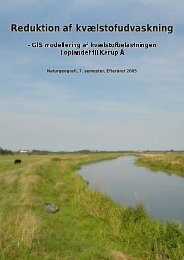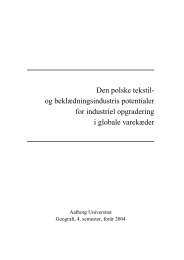Deglaciation dynamics following the Little Ice Age on Svalbard:
Deglaciation dynamics following the Little Ice Age on Svalbard:
Deglaciation dynamics following the Little Ice Age on Svalbard:
Create successful ePaper yourself
Turn your PDF publications into a flip-book with our unique Google optimized e-Paper software.
Søren H. Rasmussen<br />
<str<strong>on</strong>g>Deglaciati<strong>on</strong></str<strong>on</strong>g> <str<strong>on</strong>g>dynamics</str<strong>on</strong>g> <str<strong>on</strong>g>following</str<strong>on</strong>g> <str<strong>on</strong>g>the</str<strong>on</strong>g> <str<strong>on</strong>g>Little</str<strong>on</strong>g> <str<strong>on</strong>g>Ice</str<strong>on</strong>g> <str<strong>on</strong>g>Age</str<strong>on</strong>g> <strong>on</strong> <strong>Svalbard</strong>:<br />
Implicati<strong>on</strong> of debris-covered glaciers dynamic and morphological setting<br />
Figure 2. A landsystem model for a typical terrestrial <strong>Svalbard</strong> poly<str<strong>on</strong>g>the</str<strong>on</strong>g>rmal glacier (Glasser and<br />
Hambery, 2006, Fig. 4.10).<br />
Moraine-mound complexes: rich relief,<br />
l<strong>on</strong>g and short linear ridges, slops<br />
around 30 o and thrusting.<br />
Inner z<strong>on</strong>e: field with flutes, stream-lined<br />
ridges and melt out debris, usually<br />
reworking by glaciofluvial processes.<br />
Based <strong>on</strong> radio-echo soundings and<br />
glaciological investigati<strong>on</strong>s it is believed<br />
that Larsbreen is largely cold-based.<br />
Platåbreen is smaller and lying at a higher<br />
altitude, <str<strong>on</strong>g>the</str<strong>on</strong>g>refore it is also believed to be<br />
largely cold-based (Lukas et al., 2005). For<br />
analytic purpose it is assumed to be<br />
valuable to compare <str<strong>on</strong>g>the</str<strong>on</strong>g> two glaciers with<br />
Glasser and Hambery (2006) model for a<br />
typical terrestrial <strong>Svalbard</strong> poly<str<strong>on</strong>g>the</str<strong>on</strong>g>rmal<br />
glacier even thou <str<strong>on</strong>g>the</str<strong>on</strong>g>y are largely coldbased.<br />
The different between a cold-based<br />
and a poly<str<strong>on</strong>g>the</str<strong>on</strong>g>rmal glacier are that poly<str<strong>on</strong>g>the</str<strong>on</strong>g>rmal<br />
glacier has <strong>on</strong>ly <str<strong>on</strong>g>the</str<strong>on</strong>g> terminus<br />
frozen to <str<strong>on</strong>g>the</str<strong>on</strong>g> ground where <str<strong>on</strong>g>the</str<strong>on</strong>g> cold-based<br />
Page 4 of 15<br />
glacier is total frozen to <str<strong>on</strong>g>the</str<strong>on</strong>g> ground. The<br />
comparis<strong>on</strong> is assumed to be valid because<br />
both types have a frozen terminus and<br />
<str<strong>on</strong>g>the</str<strong>on</strong>g>reby nearly <str<strong>on</strong>g>the</str<strong>on</strong>g> same land-forming<br />
processes at <str<strong>on</strong>g>the</str<strong>on</strong>g> terminus.<br />
Geological settings<br />
The bedrock in <str<strong>on</strong>g>the</str<strong>on</strong>g> study area is<br />
sedimentary, mostly shale and some layers<br />
of sandst<strong>on</strong>e. The bedrock is soft <str<strong>on</strong>g>the</str<strong>on</strong>g>refore<br />
glaciers, running water and frost shattering<br />
easily erode it (Lønne and Lyså, 2005).<br />
Wea<str<strong>on</strong>g>the</str<strong>on</strong>g>ring of <str<strong>on</strong>g>the</str<strong>on</strong>g> bedrock and <str<strong>on</strong>g>the</str<strong>on</strong>g><br />
enclosed debris is dominating al<strong>on</strong>g <str<strong>on</strong>g>the</str<strong>on</strong>g><br />
slops. There are coal bearing layer and<br />
fossil leaves and o<str<strong>on</strong>g>the</str<strong>on</strong>g>r plants remains can<br />
be found, some places <str<strong>on</strong>g>the</str<strong>on</strong>g>y are comm<strong>on</strong>.<br />
The mean annual air temperature is -6 o<br />
C, measured at <str<strong>on</strong>g>the</str<strong>on</strong>g> L<strong>on</strong>gyearbyen Airport.<br />
The airport is situated 5 km north of<br />
Platåbreen, around 25 m altitude, at <str<strong>on</strong>g>the</str<strong>on</strong>g><br />
foot of Platåbjerget (Lukas et al., 2005).







